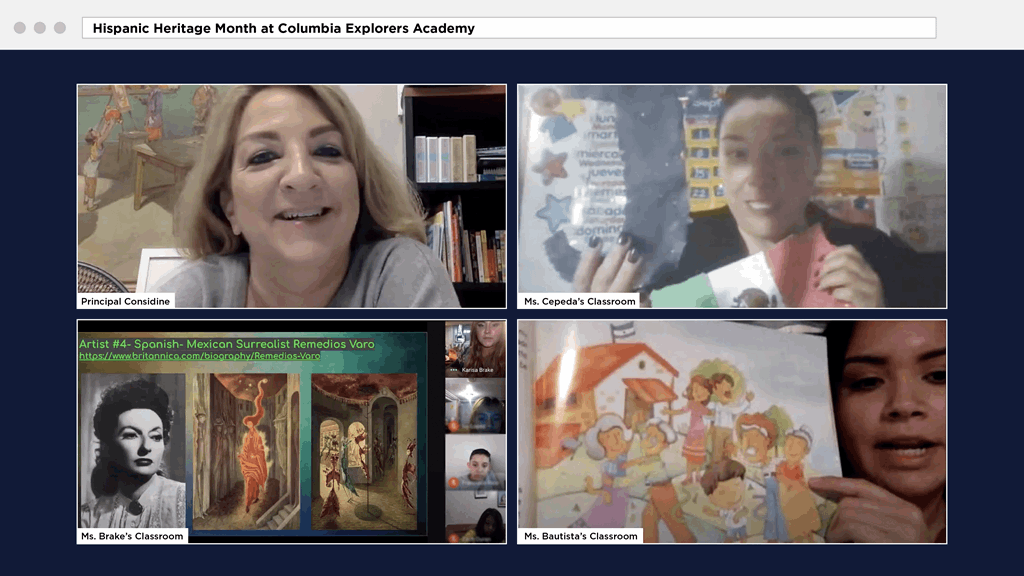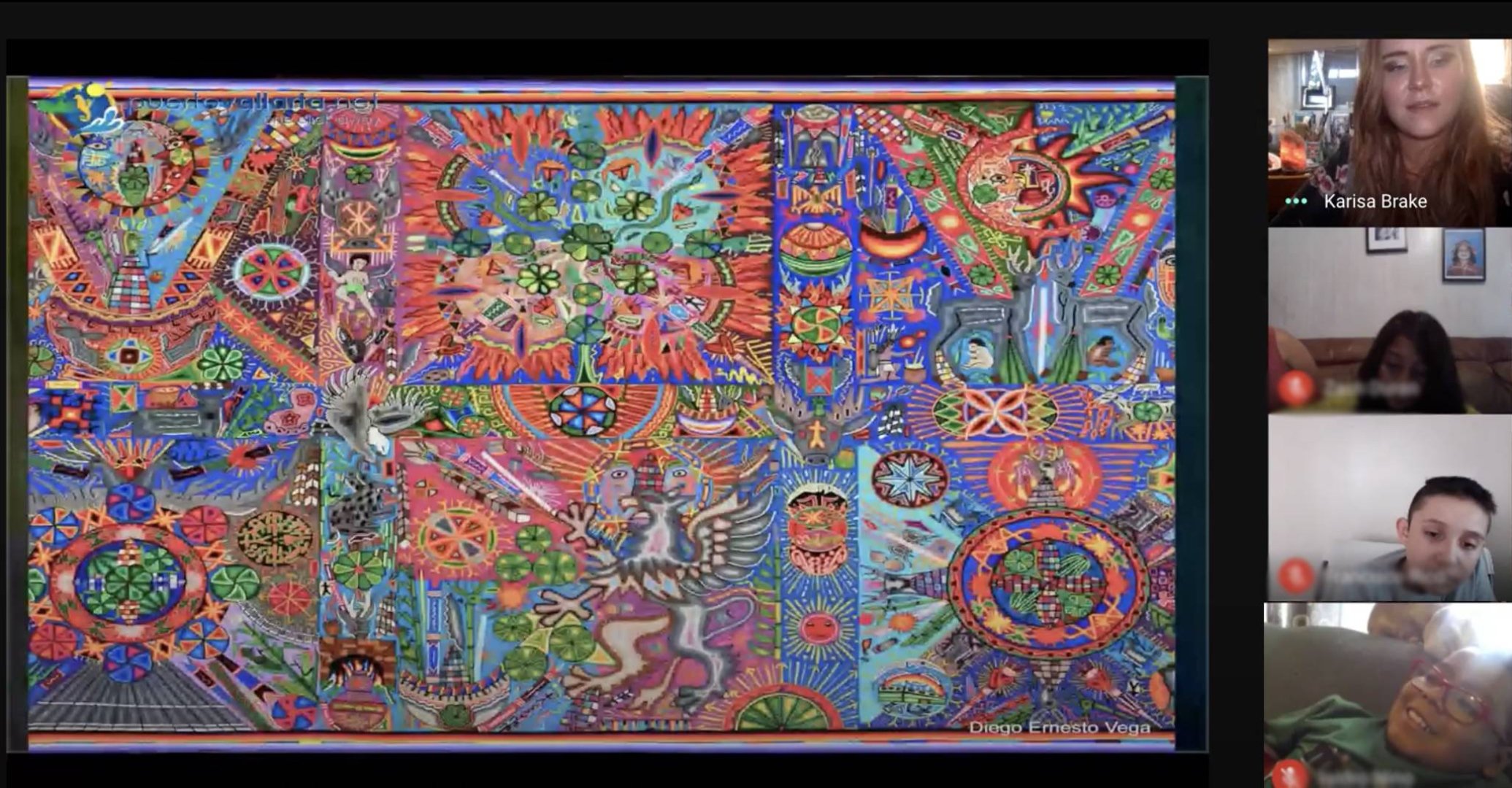Hispanic Heritage Month Woven Throughout Instruction at Columbia Explorers
01 October 2020
Teachers and staff see the value in recognizing every student’s unique background.

Principal Eileen Considine vividly remembers the restaurant at 25th and Kedzie owned by the family of her two childhood best friends. She says that she would try to make quesadillas at home that compared to the ones she had in Little Village and was never quite able to make them taste as good.
She grew up in Archer Heights when it was still predominantly White, and stayed on the Southwest Side to teach seeing its demographics shift to predominantly Latinx. Fast forward a few decades, and she’s now the principal of Columbia Explorers Academy in Brighton Park. She believes that fostering a sense of community at the school is her most important role.
“People who aren’t familiar with Chicago Public Schools or teaching always ask me: ‘Why do you do it?’ and I always say: ‘What do you mean?’” said Principal Considine. “These kids are amazing and these families are so invested in their kids.”
Some of the strong relationships forged at Columbia Explorers are reflective of Principal Considine’s entire career. First-year teacher Ms. Adriana Bautista, a second-grade bilingual teacher, was a student in her eighth-grade English class over a decade ago. Even though she knew she was beginning her career as a teacher in an unexpected way, she decided doing so under her former teacher was the right place to start.
“The pandemic stopped a lot of people from even wanting to take on a position in teaching, but I kept telling myself that this is what I chose and that I could do it,” said Ms. Bautista. “I didn’t want to wait another year because I knew that I would learn from this and it would make me a better person in the long run.”
For Hispanic Heritage Month, Ms. Bautista chose to read René tiene dos apellidos—René Has Two Last Names—to her class. After looking at her roster and noticing that many of her students had two last names, she wanted them to be able to form connections to the book’s core theme of acceptance. At the same time, René’s Salvadorian background helped her show her students that Hispanic Heritage Month extends beyond Mexico.
“I wanted to touch base on the fact that there are more cultures out there—not just the Mexican culture—and we have to be respectful of that,” said Ms. Bautista. “For example, the book mentions pupusas, which many students have not had, but they have had sopes, so I was able to make that connection with them.”
Art teacher Ms. Karisa Brake has a few things in common with Ms. Bautista: she’s also a first-year teacher who sees the value in expanding her students’ cultural perceptions. She created Mexican Artist Appreciation Week in her classroom to expose them to a diverse set of artwork, from Huichol yarn paintings to the surrealist works of Remedios Varo.

“Students love to find little pictures within a larger work, so I tried to pick artists with really intriguing work or that incorporated hidden images,” said Ms. Brake. “I also try to tie the historical artists together with current working creators so that every student can find something to appreciate.”
That’s why she’s focused on finding ways to make her projects more inclusive. One example is the papel picado. While these colorful Mexican decorations are typically made of tissue paper, she says that every student had some form of paper at home that they could use to make them.
Meeting students where they are is also important to veteran teacher Ms. Jane Cepeda, even though her students are still discovering themselves as part of her pre-k classroom. Helping her students become comfortable speaking up and sharing how they feel is a key piece of her instruction, so, for Hispanic Heritage Month, she read El mejor mariachi del mundo—The Best Mariachi in the World—which follows Gustavo, a young boy who feels sad when he cannot play any instruments, but then feels happy when he discovers that he can sing.
On top of reading the book and talking about feelings, Ms. Cepeda then taught her class about the celebratory nature of a mariachi band, which she says came naturally to her because it brought back memories of her own experiences celebrating Mexican Independence Day while growing up in Chicago. She also had a discussion with her class about what the different colors of the Mexican flag symbolize—all in one class period.
“As a teacher, I want my students to remember me as someone who taught them something new and something different,” said Ms. Cepeda. “I never want them to say that I was a mean teacher. I want them to say that Ms. Cepeda taught me about the colors of the flag, that she said that mariachis celebrate Mexican independence.”
Every teacher—whether they are a veteran teacher like Ms. Cepeda or a new teacher like Ms. Bautista and Ms. Brake—had a hand in creating a successful virtual Hispanic Heritage Month at Columbia Explorers. Principal Considine says being remote has only reaffirmed the importance of recognizing every student’s unique background.
“What I think we have to remember is that, regardless of the situation, we have to celebrate our students and their culture,” said Principal Considine. “Talking to our students and their parents about what is going on at home and letting them know that we are here for them and appreciate them is how you build relationships.”
Celebración del Mes de la Herencia Hispana en la Columbia Explorers Academy
La directora Eileen Considine recuerda vívidamente el restaurante, ubicado en la intersección de las calles 25 y Kedzie, que le pertenece a la familia de sus dos mejores amigos de la infancia. Dice que en casa intentaba hacer quesadillas similares a las que había probado en La Villita, pero nunca pudo hacerlas tan ricas.
Creció en Archer Heights cuando la vecindad todavía predominaba la población de raza blanca, y permaneció en el lado suroeste de la ciudad para enseñar, al ver que el grupo demográfico cambiaba a ser mayoritariamente latino. Unas décadas después, se convirtió en la directora de la Columbia Explorers Academy en Brighton Park. Cree que su papel más importante es fomentar un sentido de comunidad en la escuela.
“La gente, que no está familiarizada con las Escuelas Públicas de Chicago o con la enseñanza, siempre me pregunta: ‘¿Por qué lo haces?’ y yo siempre contesto: ‘¿Qué quieres decir con eso?’” dijo Considine. “Estos son niños increíbles y sus familias están muy comprometidas con sus hijos”.
Algunas de las sólidas relaciones, que se han forjado en la escuela, reflejan toda la carrera de la directora Considine. Hace más de una década, le enseñaba inglés a una estudiante de octavo grado, Adriana Bautista, que actualmente es una maestra bilingüe de segundo grado en su primer año de enseñanza. Aunque Bautista sabía que empezaría su carrera de forma inesperada, decidió que hacerlo bajo el liderazgo de su antigua maestra sería lo más adecuado.
“La pandemia desmotivó a mucha gente a asumir un puesto docente, pero yo me seguía diciendo que esto era lo que había elegido, y que sí podía hacerlo”, dijo Bautista. “No quería esperar un año más porque sabía que aprendería de esta experiencia, y que esto me haría una mejor persona a largo plazo”.
Para el Mes de la Herencia Hispana, Bautista eligió leerle René tiene dos apellidos a su clase. Después de haber notado en su lista que muchos de sus estudiantes tenían dos apellidos, quería que los mismos fueran capaces de formar conexiones con el tema central del libro, la aceptación cultural. Al mismo tiempo, los antecedentes salvadoreños de René les permitió mostrarles a sus estudiantes que el Mes de la Herencia Hispana se extiende más allá de México.
“Quería destacar el hecho de que hay muchas otras culturas —no solo la cultura mexicana—, y de que tenemos que respetar eso”, dijo. “Por ejemplo, el libro menciona las pupusas, que muchos estudiantes no han probado, pero como sí han comido los sopes, pude hacer esa conexión con ellos”.
La maestra de arte Karisa Brake tiene algunas cosas en común con Bautista: también está enseñando en su primer año y ve el valor de expandir las percepciones culturales de sus estudiantes. Brake creó, en su aula, la Semana de Reconocimiento a los Artistas Mexicanos, para exponerlos a un diverso conjunto de obras de arte, desde pinturas de hilo huichol hasta las obras surrealistas de Remedios Varo.

“A los estudiantes les encanta encontrar pequeños dibujos dentro de una obra, así que traté de elegir artistas cuyos trabajos eran muy intrigantes o que incorporaran imágenes ocultas”, dijo. “También trato de relacionar a los artistas históricos con los actuales para que cada estudiante pueda encontrar algo que apreciar”.
Por eso se ha enfocado en encontrar maneras de hacer sus proyectos más inclusivos. Un ejemplo es el papel picado. Aunque estas coloridas decoraciones mexicanas típicamente se hacen con papel de seda, ella dice que todos los estudiantes tenían algún tipo de papel en casa que podían usar para hacerlas.
Adaptarse a las necesidades de los estudiantes también es importante para Jane Cepeda, una maestra veterana, aunque sus estudiantes todavía estén descubriéndose a sí mismos como parte de su clase de prekínder. Ayudar a sus estudiantes a sentirse cómodos al expresar sus opiniones y al compartir sus sentimientos son elementos esenciales de su enseñanza. Así que para el Mes de la Herencia Hispana, le leyó a la clase El mejor mariachi del mundo, que narra la historia de Gustavo, un joven que se pone triste cuando no puede tocar ningún instrumento, pero que luego se alegra cuando descubre que puede cantar.
Además de leer el libro y hablar de sus sentimientos, Cepeda impartió una clase sobre el carácter festivo de una banda de mariachis que, según ella, le surgió con naturalidad porque le trajo recuerdos de sus propias experiencias de celebrar el Día de la Independencia de México durante su niñez en Chicago. También en un período de clase conversó con sus estudiantes sobre los significados de los diferentes colores de la bandera mexicana.
“Como maestra, quiero que mis estudiantes me recuerden como alguien que les enseñó algo nuevo y diferente”, dijo. “No quiero que digan que fui una mala maestra, sino que fui alguien que les enseñé sobre los colores de la bandera y sobre cómo los mariachis celebran la independencia de México”.
Cada maestra—ya sea una maestra veterana como Cepeda o una nueva maestra como Bautista y Brake—contribuyó al exitoso evento virtual para el Mes de la Herencia Hispana en la Columbia Explorers. La directora Considine dice que el hecho de que el mismo se haya llevado a cabo virtualmente solo ha reafirmado la importancia de reconocer los antecedentes únicos de cada estudiante.
“Lo que creo que tenemos que recordar es que, independientemente de la situación, tenemos que homenajear a nuestros estudiantes y su cultura”, dijo Considine. “Hablarles a nuestros estudiantes y sus padres, sobre lo que ocurre en casa, y hacerles saber que estamos aquí para ellos y que los apreciamos son maneras de construir relaciones”.
Related Stories
09 May 2025
Learning Alongside My Students: Take Five with Melissa Flisk
Ms. Flisk strives to create a calm and welcoming environment that celebrates her students’ interests, needs, skills, and personalities.
07 May 2025
Learning All About an Amazing Art Educator for Teacher Appreciation Week
Natalie loves working with students, especially those who enter her classroom without a lot of confidence in their abilities.
07 May 2025
Celebrating Teacher Appreciation Week with an Outstanding Third-Grade Educator
Reem is doing an amazing job in her first year leading a classroom of her own.
05 May 2025
Making the World a Bigger and Better Place for Students with Visual Impairments
Ms. Segroves is dedicated to providing students with direct instruction and accommodations to help them access everyday instruction.




